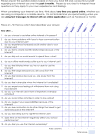The Problematic and Risky Internet Use Screening Scale (PRIUSS) for Adolescents and Young Adults: Scale Development and Refinement
- PMID: 24882938
- PMCID: PMC4035908
- DOI: 10.1016/j.chb.2014.01.035
The Problematic and Risky Internet Use Screening Scale (PRIUSS) for Adolescents and Young Adults: Scale Development and Refinement
Abstract
Problematic Internet use (PIU) is a growing health concern among adolescents and young adults. The purpose of this mixed-methods study was to develop and refine a theoretically-grounded and psychometrically-validated assessment instrument for PIU specifically tailored to adolescents and young adults. An item pool was developed using concept mapping and a review of the literature, and administered to 714 students from two universities between 18 and 25 years of age. Exploratory and confirmatory factor analyses were used in a development subsample (n=500) to construct the scale. A cross-validation sample (n=214) was used to confirm the scale's reliability. The Problematic and Risky Internet Use Screening Scale (PRIUSS) is an 18-item scale with three subscales: Social Impairment, Emotional Impairment, and Risky/Impulsive Internet Use. Based on its strong theoretical foundation and promising psychometric performance, the PRIUSS may be a valuable tool for screening and prevention efforts in this population.
Keywords: Internet use; concept mapping; problematic Internet use; psychometrics; scale development; screening.
Conflict of interest statement
The authors do not have any financial disclosures nor conflicts of interest to report.
Figures
Similar articles
-
Screening for Adolescent Problematic Internet Use: Validation of the Problematic and Risky Internet Use Screening Scale (PRIUSS).Acad Pediatr. 2015 Nov-Dec;15(6):658-65. doi: 10.1016/j.acap.2015.07.001. Acad Pediatr. 2015. PMID: 26547545
-
Development and Testing of a 3-Item Screening Tool for Problematic Internet Use.J Pediatr. 2016 Sep;176:167-172.e1. doi: 10.1016/j.jpeds.2016.05.067. Epub 2016 Jul 6. J Pediatr. 2016. PMID: 27395768 Free PMC article.
-
A Trying Time: Problematic Internet Use (PIU) and its association with depression and anxiety during the COVID-19 Pandemic.Child Adolesc Psychiatry Ment Health. 2022 Jun 23;16(1):49. doi: 10.1186/s13034-022-00479-6. Child Adolesc Psychiatry Ment Health. 2022. PMID: 35739549 Free PMC article.
-
Problematic Internet Use: A longitudinal study evaluating prevalence and predictors.J Pediatr X. 2019 Spring;1:100006. doi: 10.1016/j.ympdx.2019.100006. Epub 2019 Jul 26. J Pediatr X. 2019. PMID: 34308328 Free PMC article.
-
Linking parental mediation practices to adolescents' problematic online screen use: A systematic literature review.J Behav Addict. 2019 Dec 1;8(4):649-663. doi: 10.1556/2006.8.2019.61. Epub 2019 Dec 2. J Behav Addict. 2019. PMID: 31786936 Free PMC article.
Cited by
-
Negative psychological and physiological effects of social networking site use: The example of Facebook.Front Psychol. 2023 Aug 3;14:1141663. doi: 10.3389/fpsyg.2023.1141663. eCollection 2023. Front Psychol. 2023. PMID: 37599719 Free PMC article. Review.
-
Current Research and Viewpoints on Internet Addiction in Adolescents.Curr Pediatr Rep. 2021;9(1):1-10. doi: 10.1007/s40124-020-00236-3. Epub 2021 Jan 9. Curr Pediatr Rep. 2021. PMID: 33457108 Free PMC article. Review.
-
Prevalence and Risk Factors of Internet Addiction among Hungarian High School Students.Int J Environ Res Public Health. 2021 Jun 30;18(13):6989. doi: 10.3390/ijerph18136989. Int J Environ Res Public Health. 2021. PMID: 34208800 Free PMC article.
-
Parental Monitoring of Early Adolescent Social Technology Use in the US: A Mixed-Method Study.J Child Fam Stud. 2024;33(3):759-776. doi: 10.1007/s10826-023-02734-6. Epub 2023 Dec 18. J Child Fam Stud. 2024. PMID: 40621594 Free PMC article.
-
Is There a Relationship Between Youth Bullying and Internet Addiction? An Integrative Review.Int J Ment Health Addict. 2022 Jan 6:1-25. doi: 10.1007/s11469-021-00731-8. Online ahead of print. Int J Ment Health Addict. 2022. PMID: 35018144 Free PMC article.
References
-
- Anderson KJ. Internet use among college students: An exploratory study. Journal of American College Health. 2001;50(1):21–26. - PubMed
-
- Brown MW, Cudeck R. Alternative ways of assessing model fit. In: Bollen KA, Long JS, editors. Testing structural equation models. Newbury Park, CA: Sage; 1993. pp. 136–162.
-
- Caplan SE. Problematic Internet use and psychosocial well-being: development of a theory-based cognitive-behavioral measurement instrument. [Article] Computers in Human Behavior. 2002;18(5):553–575.
-
- Covell K, Dion K, Dion K. Gender differences in evaluations of tobacco and alcohol advertisements. Canadian Journal of Behavioral Sciences. 1994;26:404–420.
Grants and funding
LinkOut - more resources
Full Text Sources
Other Literature Sources



